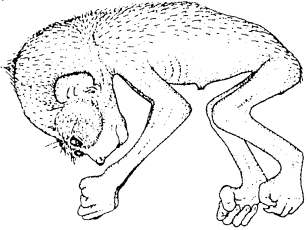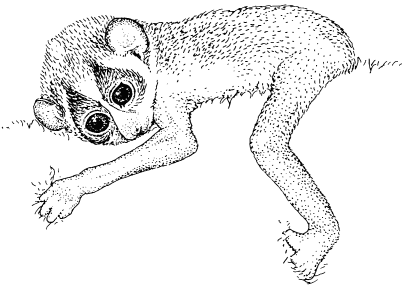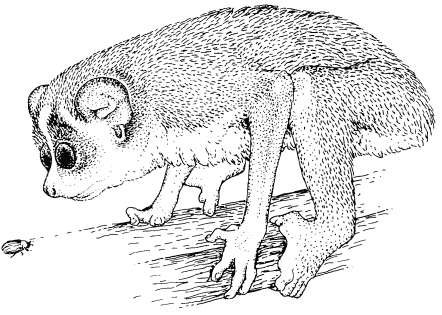
|

|
| Home |
|
|
Literature |
|
Age determination in lorises and pottos
Age grades, based on Schultz (1959) and other sources:
Fetus: all stages of prenatal life between the embryonic
and
the newborn.
Infant: from shortly after birth to, but not including, the
appearance of the first permanent teeth
Juvenile I: stage during which the first few permanent
teeth
erupt.
Juvenile II: all later phases of dental eruption,
following
as a rule after a considerable period of rest, until the last
teeth have
appeared, though without full occlusion
"Subadult": animal not yet fully grown, but clearly too old
to be classified as dependent young. Subadult specimens may
already be
sexually mature (Ansell 1965).
"Adult": from the completion of dentition to the stage in
which
most teeeth have become strongly worn and certain cranial sutures
are closed
(Schultz 1959).
Since the word "adult" in literature is not used in an
unmistakeable
way, Ansell (1965) proposes to distinguish between the following
adult
stages not necessarily coinciding:
a) with complete permanent dentition (a
frequent
taxonomic criterion for adulthood)
b) physically mature (having reached maximum
body
development)
c) sexually mature
Senile: according to Schultz very old specimens with
extreme
wear of the teeth and signs of bony atrophy. In captive Loris,
in
animals of 11 to more than 15 years who partly showed other signs
of ageing
towards the end of their life, little toothwear was found.
Instead, a variety
of other changes independently occurred, including grey to white
facial
hair (circumocular patches), patchy pigmentation of the skin,
decreased
vision, cataract, loss of weight, thinning of the fur, loss of
some teeth
and tartar, but onset of these changes varied individually.
Infant development in L. t. nordicus

|

|

|
Behavioural and weight development in captive-bred mother-reared single offspring and twins of L. t. nordicus from Polonnaruwa, Sri Lanka. Data: B. Meier

Age-related changes in captive L. t. nordicus from
Polonnaruwa
Neonate colour: light grey to reddish-grey with few darker stiff
hairs,
with a reddish dorsal stripe and reddish circumocular patches.
Limbs almost
naked, unpigmented, ears with slightly pigmented rims.
Juveniles: light yellowish without white frosting (white hair
tips),
with reddish circumocular patches; ears yellowish with slightly
pigmented,
darker rims.
Change to grey adult colour: gradual; usually the development of
some
blackish hair in the upper part of circumocular patches is noticed
first
(starting at the age of about 6 months or later). The yellowish
juvenile
coat gradually changes into adult grey colour with more or less
frosting,
with some chestnut hair on the forehead in some subadult
specimens. The
ear pigmentation vanishes. Adult colour: usually pure grey, seldom
yellowish-grey.
Specimens in some recorded cases resembled their parents at the
age of
16 to 21 month.
The skin of younger adults is unpigmented and yellowish or pink.
With
increasing age, an irregular, grey pigmentation may develop. It is
particularly
visible on muzzle, ears (particularly ear rims) and dorsum of
hands and
feet. The age of onset of this pigmentation varies individually.
In ageing animals, the fur of the face, and to a lesser degree of
the
trunk, may become increasingly grey to almost white. One specimen
with
initially almost black circumocular hair was already rather grey
at the
age of five years and at the age of 9 years showed a very light
grey to
almost white face, a feature apparently inherited from the
wildcaught father
who also showed some white facial hairs at a rather early age and
was almost
white when he died after 13 years in captivity. Another wildcaught
female
after 13 years in captivity still showed black circumocular
patches without
white hair.
Some information for slow lorises and pottos: see table
including
juvenile colour descriptions in the population database
References, further age determination
literature:
Ansell, W. F. H., 1965: Standardisation of field data on
mammals.
Zoologica Africana 1 (1): 97-113.
Berry, R. J., 1970: Covert and overt variation, as
exemplified
by British mouse populations. Symp. zool. Soc. Lond. 26:
3-26.
Berry, R. J.; Truslove, G. M., 1968: Age and lens weight in
the house mouse. J. Zool. Lond. 155: 247-252.
Deol, M. S.; Grüneberg, H.; Searle, A. G.; Truslove, G. M.,
1951: Genetical differentiation involving morphological characters
in an
inbred strain of mice. I. A British branch of the C57BL strain. J.
Morph.
100:
345-376.
Jungers, W. L., 1985: Body size and scaling of limb
proportions
in primates. Pp. 345-381 in: W. L. Jungers (ed.): Size and scaling
in primate
biology. Plenum Press, New York.
Martin, R., 1914: Lehrbuch der Anthropologie. Gustav
Fischer
Verlag, Jena.
Molez-Verričre, N.; Vincent, F., 1997: Dental age
determination
in young bushbabies. Folia Primatologica 68: 106-109
Schultz, A. H., 1959: Post-embryonic age changes. Pp.
887-964
in: Primatologia I, Hofer, H.; Schultz, A. H.; Starck, D. (eds.),
Karger,
Basel.
Silberberg, M.; Silberberg, R., 1941: Age changes of bones
and
joints in various strains of mice. Am. J. Anat. 68: 69-95.
| Population database - Measurung standard
for taxonomic
purposes
Preliminary draft; H. Schulze |
Last amendment: 24 March 2002 |